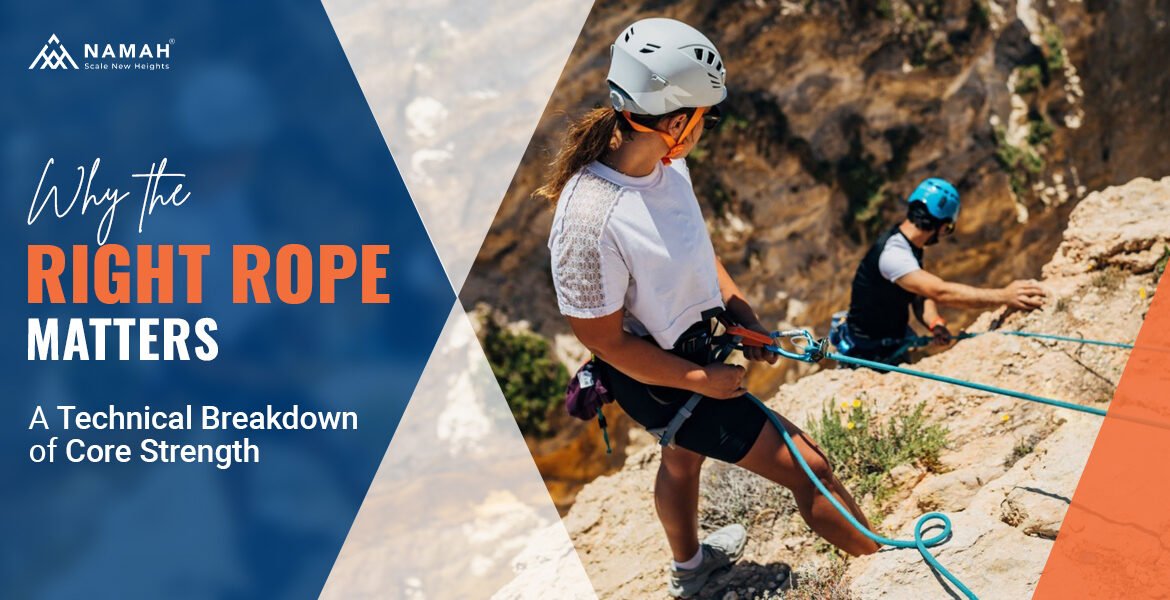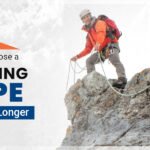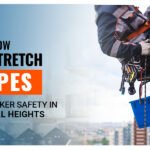When you hang your life or your team’s plan on a rope, “good enough” isn’t good enough. Whether it’s a climber taking a lead fall, a rescuer lowering a patient, a technician on rope access, or a crew towing in a squall, the same truth applies: the rope must perform as promised, every time. That promise is built from the inside out, with fiber choice, construction, finishes, and the way it has been tested and rated.
At Namah, we think of strength as a conversation between physics and real-world use. It’s why we publish clear use-cases across our range: dynamic ropes for fall absorption, semi-static ropes for controlled movement and hauling, twin and light lines for alpine efficiency, even marine ropes for harsh, wet environments. Strength numbers matter, but the story behind them matters more.
Strength: more than one number
Rope strength is shorthand for a set of behaviors under load: peak force the rope can withstand before failure (tensile strength), how it handles shocks (impact force), how much it stretches when things go wrong (dynamic elongation), and how little it moves when things must stay steady (static/working elongation). When a rope “feels strong,” what you’re noticing is that interplay working in your favor: predictable catches, controlled descents, no surprises.
Tensile strength—your ceiling
Tensile strength is the maximum load a rope can withstand in a controlled test. Construction and fiber choice drive this: the core carries the load; the sheath protects the core so it can keep doing that job. For life-safety ropes, tensile strength must clear high bars—and stay there after cycles of abrasion, moisture, and heat. That’s the base layer of trust.
Impact force—your margin for error
Impact force is what you feel in a fall: it’s the peak energy transmitted to the system as the rope arrests motion. In climbing, a well-tuned dynamic rope spreads that energy through controlled stretch, softening the catch for your body and the anchors. In rescue, even “static” systems are engineered for low working elongation but still manage force with knots, friction, and rigging to avoid shock loads.
Dynamic vs static elongation—two different jobs
Dynamic elongation is intentional under sudden load. It buys time and lowers peak forces. Static (working) elongation is the opposite: in rope access, industrial positioning, and rappels, you want minimal bounce so movements are precise. That’s where semi-static constructions (often marketed as “static”) live: low stretch in the working range, predictable handling, and high durability around devices.
Materials: the feel comes from the fiber
A rope’s personality starts with its fibers. Here’s how the major players show up in real life:
Nylon (polyamide).
The classic for dynamic climbing ropes. Tough, energetic, and forgiving, nylon core yarns deliver the stretch you want in a fall and recover well afterward. Pair nylon’s resilience with a robust sheath, and you get a line that handles hard use without feeling “dead.” You’ll see that balance in our dynamic ropes, where the priority is a soft catch with dependable handling.
Polyester.
Stable when wet, UV-resistant, and naturally low-stretch. It’s the backbone for many semi-static ropes used in rescue, rope access, caving, and canyoning. Polyester helps keep systems precise under load, which is exactly what you want when the brief is “control, not bounce”—a hallmark of our semi-static range.
UHMWPE
Incredibly high strength-to-weight and very low elongation. Fantastic in slings, rigging, towing, and marine applications where weight savings and cut resistance are critical—but sensitive to heat buildup in friction devices. You’ll see UHMWPE in purpose-built products and accessories rather than as a primary life-support climbing line.
Aramid blends
Heat-resistant, abrasion-tough covers for specialty tasks (lanyards, cut-resistant sheath components, high-temperature environments). Minimal stretch makes them great for protection, not for catching big, dynamic falls.
No single fiber “wins.” The right answer is the right blend and braid for the job, tuned by construction.
Construction: Why Kernmantle became the gold standard
Most modern life-safety ropes use kernmantle construction: a high-strength core (kern) protected by a woven sheath (mantle). The core is your engine, long, aligned filaments engineered to take a load. The sheath is your armor built to shrug off abrasion, dirt, and UV, while delivering a “hand” that ties, feeds, and rappels the way you expect.
In practice, sheath percentage and weave density are massive levers. A denser sheath with higher coverage resists fuzzing on textured rock, concrete edges, canyon grit, and rough lowering surfaces. That’s why two ropes with similar diameters can age very differently. On our product pages, you’ll notice we speak to use-cases (gym abuse, mixed rock, water exposure) rather than just listing specs because sheath design is where longevity is won or lost.
Standards: the language of trust
Independent testing is what turns a rope into PPE. UIAA/EN standards define fall tests, elongation limits, and labeling for dynamic ropes; CE and ISO frameworks ensure quality systems and compliance. Across Namah’s range of dynamic singles, half/twin systems, semi-static work lines, harnesses, and slings, you’ll see those marks clearly called out on product/category pages and marketing channels. This isn’t decoration; it’s your audit trail.
Choosing by application (with smart site links)
Climbing & Mountaineering.
Lead falls demand energy absorption and a supple catchstart with a certified dynamic single. If your season leans alpine or mixed, consider lighter diameters and dry treatment. Explore: Dynamic Ropes.
Rescue & Rope Access.
Precision matters more than bounce. Semi-static lines give controlled movement, predictable lowers, and firm work positioning. Explore: Semi-Static Ropes.
Caving & Canyoning.
Look for abrasion-tough sheaths, low water uptake, and dry-treated options that handle repeated rappels and gritty pulls. Start here: Caving/Canyoning articles & ropes.
Marine & Offshore.
UV, salt, and constant wetting require different chemistries and finishes. If your task is docking, anchoring, or towing, shop purpose-built lines: Marine Ropes.
Alpine Efficiency & Dual-rope Systems.
For long rappels, traverses, and drag reduction, twin/half systems always follow the certified use rules. Explore: Twin Ropes.
How we test (and why it matters to you)
Every label tells part of the story; our process fills in the rest. In development, we cycle ropes through abrasion, wet/dry exposure, and repeated loading before they reach certification testing. In production, samples are pulled from batches for tensile and elongation checks. Then we verify device compatibility across common belay/rappel tools in the rope’s intended diameter band. It’s not glamorous work, but it’s why the rope in your hands behaves like the one you read about online. If you want the deep dive, contact us; we’re proud of how we build.
Handling: the “feel” you notice on Day 1 and Day 101
Strength specs get you to the crag. Handling keeps you there. That’s the part you sense when you tie a figure-eight with cold fingers, feed slack for a desperate clip, or stack two 60s at a windy rappel. We tune hand through sheath weave, heat-setting, and finishing so the rope stays supple without going mushy, keeps its roundness under load, and resists glazing on long lowers. The goal isn’t a showroom feel; it’s familiar performance after months of real use.
If you prefer a calmer hand for daily abuse, choose from our tougher sheaths in the semi-static or mid-9 dynamic band. If you’re counting grams on long days, look at the lighter lines in dynamic and plan to reserve them for your send days.
Bringing it together: how to choose
If you’re a climber, begin with a dynamic single that matches your local routes. If your climbing mixes gym mileage with outdoor projects, consider a two-rope approach: one durable “workhorse” and one lighter “send” line so each lasts longer and performs better when it counts. Start here: Climbing Ropes overview.
If you’re in rescue or rope access: choose semi-static lines sized for your devices and expected loads, pair with the right hardware and friction management, and track usage carefully. Explore: Semi-Static Ropes.
If you work on water, pick marine-rated lines designed for UV, salt, and constant wetting. Your hands and hardware will notice the difference. Explore: Marine Ropes.
If you’re building a full kit, match the rope to the role, and keep handling consistent across your quiver so muscle memory carries between lines. That’s a design goal across the Namah range, from ropes to harnesses and slings, because a coherent ecosystem reduces mistakes when days get long.
From our test bench to your hands
In the workshop, strength is not abstract. It is the thud of a drop test, the hiss of a rope pulling through a device, the tiny scuffs on a sheath that tell you where the day was won. That is how we build at Namah. We choose fibers for the job, tune the core for how it should move under real loads, and shape the sheath so it stays trustworthy long after the first few outings.
If you climb, rescue, access, or work on water, the right rope is the quiet partner that lets you focus on the task instead of the gear. Pick for the demands you face, care for it like a tool you rely on, and retire it when it asks for rest. When you are ready to choose, start where purpose meets proof: explore our Dynamic Ropes, dial in control with Semi-Static Ropes, or kit out for harsh environments with Marine Ropes. If you want help matching a line to your reality, send us a note with your terrain, device, and load profile. We will point you to a rope that feels right on Day 1 and still feels right on Day 101.




